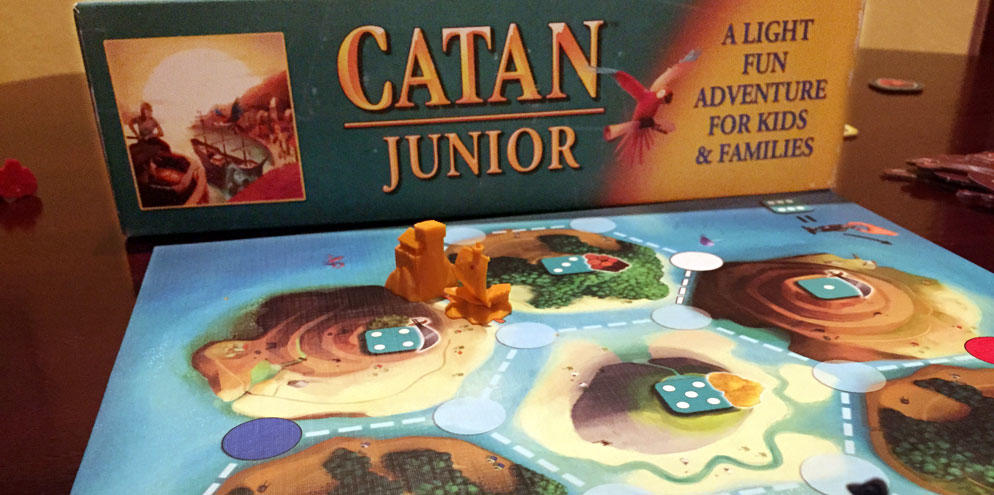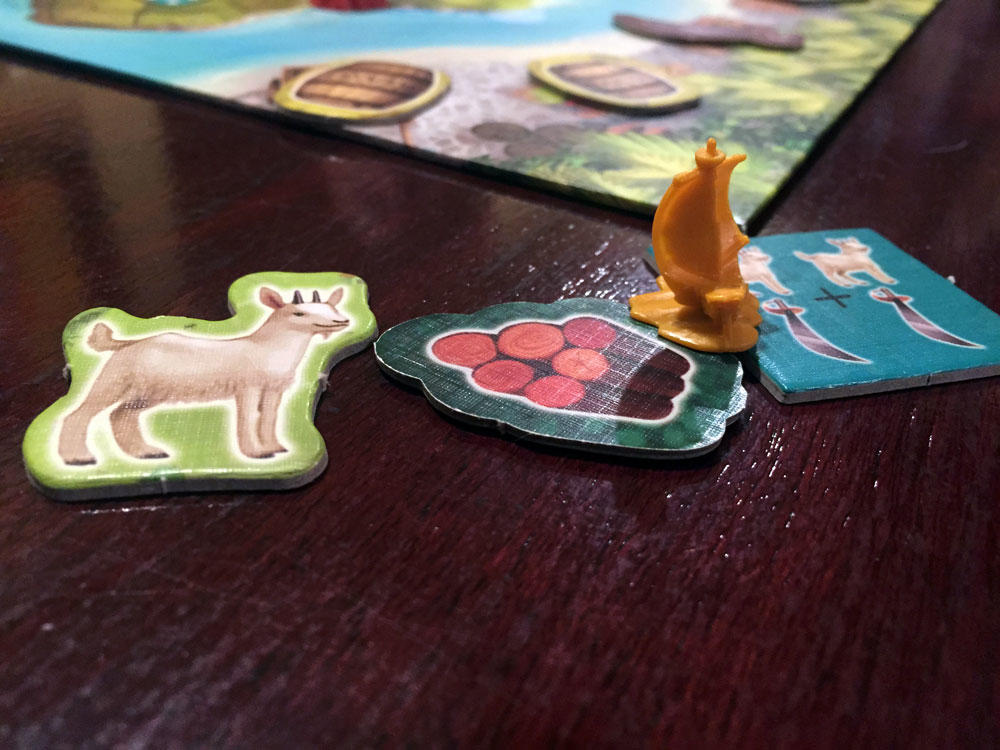It’s back to school time in our house! Isaac is focusing on reading, writing and long division in 3rd grade. Anika has been reviewing the four mathematical processors and enjoying sign language in 2nd grade.
For our family, we believe there are three types of homework:
- Homework that is assigned by their teacher to review and master the concepts presented in class.
- Homework that consists of playing outside by running, jumping, biking, hiking, climbing, and keeping young bodies active.
- Homework that consists of playing games.
We schedule our week so that each of these types of homework will happen every 7 days.
Our first homework assignment is Catan Junior, published by Mayfair Games in 2012. Mayfair Games describes the game as a light, fun, social adventure game for kids and families. It’s for 2-4 players, ages 6+ with an attention span of at least 30 minutes. The adventure includes Coco the parrot circling above your ships around the islands of Catan. The islands produce resources that make an ideal home for pirates.
The object of the game is to build your pirate lairs around the islands, trying to reach the island of gold treasure. The islands are ruled by the Ghost Captain and once he learns of your plans, he will try to prevent you from building your lairs.
Now honestly, that’s a lovely story by Mayfair Games and it almost aligns with how the game is played. It’s true that the object is to build 7 lairs first; however, our family never raced to the gold island. We each focus on what resources we need from what islands are within reach. We also found the Ghost Captain a nuisance until we recently re-read the instructions and found that he was beneficial when you had an opportunity to move him on your turn.
We started with this game because it meets our criteria that there are little to no words necessary to play the game; however, a 6 year-old will not be able to start playing this game without you. A parent will need to read the rules and explain the game to get started. The rulebook is nicely illustrated and 6 pages long, so the amount of time before you can call your family in to begin playing is about 15 minutes.
Let’s start with our favorite parts of the game and why we continue to play this game year after year. Both Isaac and Anika are natural collectors of objects and trinkets. Isaac loves to collect Pokemon cards, those little plastic helmets or men from gumball machines, Beyblades and bigger items like Lego series. Anika on the other hand likes to collect things from nature. The collection of resources makes this game exciting for each of them. The resources are cutlasses, goats, wood, gold and molasses.
Stephanie likes to keep a tidy house, so throwing out collections would be more appealing to her; however, the idea of collecting the resources to determine your next move is her favorite part as well. Jeff enjoys gathering a large amount of these resources and then having the advantage of being able to make lots of trades with everyone and the marketplace.
So naturally the kids least favorite part of the game is when the Ghost Captain is placed on your island and your island no longer produces a resource. With the five resources you can create a lair, a ship, or purchase a Coco the parrot card. They become frustrated when the resources aren’t coming in to create the patterns necessary to build these items.
Stephanie’s least favorite part used to be when she rolled a 6. That meant she was to move the Ghost Captain onto an island to stop the production of resources. How do you choose what child to disappoint? (Editor’s Note: When in doubt, always choose Jeff to disappoint.) The last time we played though, when re-reading the instructions we found we had missed the step that once you choose what island to place the Ghost Captain you also received two resources from that island. That helped eliminate the guilt that one family member was going to be disappointed and instead she was able to choose the island that had the resource she needed most.
Jeff, being the game designer of the family, finds the static set-up of the game and the numbering of the islands to be his least favorite part. He would prefer a more dynamic approach to the game board and determining how each island produces resources like original Catan.
When we sit down to play, here are the strategies that are most common for each of us. Isaac really enjoys having Coco the parrot save the day! He stockpiles cutlasses, molasses, gold and purchases lots and lots of Coco cards, which in turn gives him extra resources for trading for more cutlasses, molasses and gold.
Whereas, Anika and Stephanie focus on building their ships and lairs. Each will gather a few resources and look for opportunities to trade resources with the marketplace or other players. Jeff focuses on keeping a balanced amount of resources at all times and will purchase a combination of Coco cards, ships and lairs.
We find that Catan Junior teaches our children how to wait their turn and pay attention to each player’s turn. They must pay attention during each player’s turn in case there are trading opportunities. This trading mechanic also imitates the social mechanic of sharing in their little lives. The youngest players for example, when they desire a toy that another child is enjoying, instead of the “take and run” strategy they could try (maybe with the suggestion of a parent) to trade toys.
Catan Junior also introduces light strategy in the fact that each player must determine their own path for winning. The strategy is based on building patterns. Each item has a pattern of resources that children can quickly identify. There are quick reference cards for each player which also makes it easy for children to learn and understand what they need to collect.
Catan Junior is a game to bring to your family gaming experience early on to begin building the idea of strategy and that there are multiple paths to winning the game. We continue to play this game as our children are getting older because it’s interesting to see if their strategies will change. It is easy to set-up and play even after a long day of school because there is no reading necessary. Rather than the typical reading, writing, and mathematical expressions for homework, Catan Junior as homework will challenge them to be creative with their resources and in selecting their strategy of items to build.
Give it a try, leave us your feedback on your kid’s strategies, what other items you want to see in the future articles, and we will look forward to sharing our experience with SET next time!
Family of Gamers Summary for Catan Junior:
- No reading to play
- Minimum downtime between turns
- Only 5 resources and 3 sets to collect
- Great interaction / sharing through trading
- Teaches introduction of strategy
- Minimum conflict – only the Ghost Captain

























